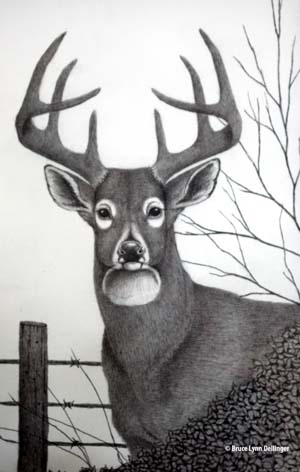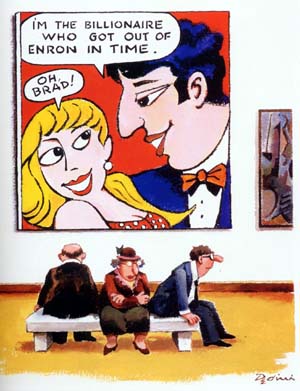“Art of Therapy” features Bruce Dellinger
By Hope Wallace
We all can learn a thing or two about ability from Bruce Lynn Dellinger. Bruce is an artist from Timberville, Virginia, whose work we are fortunate to currently have on display as part of “The Art of Therapy,” exhibit. Bruce has worked with many mediums, but he finds that a No. 2 pencil is his medium of choice to create intricate images of wildlife, animals and scenes of nature. Many of his incredibly detailed drawings can take up to 180 hours to

complete. He says that he likes to draw the natural world because he feels it best reflects his mood and his adaptability to life.
Bruce is the official artist of the Virginia Wheelin’ Sportsmen Chapter of the National Wild Turkey Federation (NWTF). He travels around the Virginia area to various festivals and activities, drawing, meeting the public and selling prints of his artwork.
Bruce is self-taught and has been successfully drawing and marketing his work for over 15 years. He does all his artwork by holding a pencil firmly between his teeth, because a farming accident in 1981 left him quadriplegic. When he discovered that he could draw by mouth, he realized how enjoyable and therapeutic making art can be.
We have three of Bruce’s beautiful drawings in The Art of Therapy exhibit. If you are interested, we have a supply of his brochures which include an order form for prints of his work.
I hope you will visit the Wassenberg Art Center often to join with us in enjoying art of all kinds. Our current exhibits, “It’s In the Cards” and “The Art of Therapy” focus on two very different types of art which both encourage interaction. These shows, sponsored by Vancrest Health Care Center, will run through May 7. Exhibit hours are 1-5 p.m. Tuesday through Sunday (closed Mondays) and admission is free.
The Wassenberg Art Center is located at 643 S. Washington Street in Van Wert, Ohio. Contact us by phone at 419.238.6837 or by e-mail at wassenberg@embarqmail.com. Check the calendar on our website, www.vanwert.com/wassenberg, for current activities.
Eldon Dedini was born to draw funny pictures
Photo caption: Cartoon by Eldon Dedini.
In the 1930s it was possible to make a living as a freelance magazine cartoonist; however, it was like doing a trapeze act without a net. Cartoonists who didn’t live near New York and Chicago — the two major centers for scores of national magazines — had to rely on the postal service to deliver their work. They also had to compete with other cartoonists who could actually meet with magazine cartoonist on weekly “look days.” On “look

days,” cartoonists could not only talk to magazine editors but also visit with other cartoonists and stay informed about news that affected their profession.
Eldon Dedini, a farm boy living in a remote rural area of California, didn’t have these options. His cartoon roughs, sketched on sheets of ordinary typewriter paper, put in an envelope and dropped in a mailbox, had to speak for him.
As a child Dedini pored over comic books and newspaper “funnies.” Before he reached high school he had set his mind on a career in comic art. His mother, an elementary teacher, bound together years of Sunday comics for him to study. He trained himself to draw by emulating the art in those bound comics and by reading books on drawing. He took a “How to Draw” mail course which included the basics of assembling batches of rough cartoon and sending them to magazine publishers for approval. Dedini sketched cartoon ideas while riding the bus to junior college 100 miles up and down the Salinas Valley every day, and began sending them out.
At first the rejection slips from the Saturday Evening Post, Look, Ladies Home Journal, and other magazines piled up. But finally, while studying art and history as a college freshman, he broke into the select ranks of Esquire Magazine cartoonists. This was an astonishing accomplishment for a 19-year-old who still lived on a farm thousands of miles from his cartoon editor. Dedini’s wit and drawing were beginning to make an impact.
From there, his career as a humorous artist slowly built. He moved to Los Angeles to attend Chouinard Art Institute, where he developed his sense of composition, color, and technique. His innate sense of humor needed no polishing.
He went on to work for Universal Studios and then for Walt Disney, while still submitting successful cartoons and gags to Esquire. In 1946 Esquire’s editor offered to double his Disney salary and put him on staff (while remaining in California) to draw cartoons and produce 100 gags a month for other Esquire cartoonists. Dedini jumped at the chance, and said good-bye to a “regular” job.
In 1950 the Esquire editor realized that Dedini’s full potential was barely being tapped, and arranged for the cartoonist to submit work to the editors of The New Yorker Magazine. This was a major turning point. The New Yorker editors welcomed and encouraged Dedini’s graphic originality.
In 1954 a young man named Hugh Hefner took the old idea that “beautiful babes help sell magazines” to a higher level, creating Playboy magazine. Hefner was a cartoonist, so the magazine included sophisticated, handsomely executed cartoons alongside substantive articles by recognized writers. “Hef” had been a copyboy at Esquire and admired Dedini’s work. For three years he kept swinging the trapeze to Dedini, inviting the cartoonist to join his contributors and offering to raise the pay each time. Finally, in 1959, with no objections from his other editors, Dedini grabbed the bar. His association with Playboy would last for the next 45 years.
Dedini’s work helped take Playboy’s image beyond that of a “men’s magazine” and into sophisticated satire covering the bar and party scene, the corporate world, international politics, jazz, mythology, and even Japanese art.
(To be continued)
POSTED: 04/20/11 at 1:34 pm. FILED UNDER: What's Up at Wassenberg?







